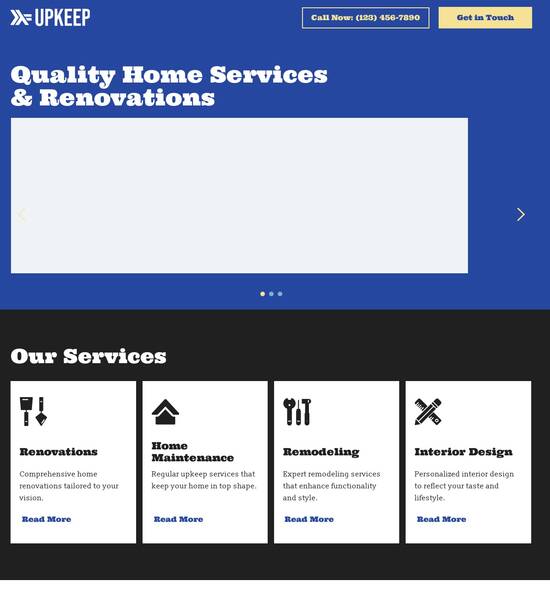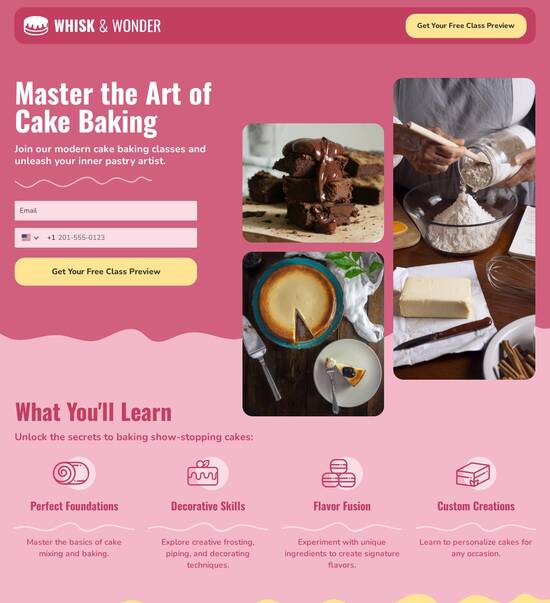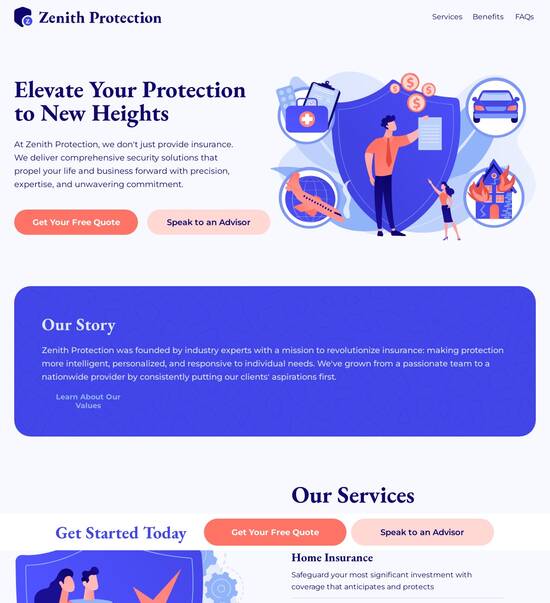
Next.js optimized story telling page template
Explore Similar TemplatesAbout template
Supercharge your story telling page with Next.js for outstanding performance! Learn more today.
Recommended templates

Easy to build without coding
With the intuitive drag-and-drop builder, anyone on your team can create high-converting pages without any knowledge of code or design. Make enhancements to your landing page with custom widgets using Javascript, HTML/CSS, or third-party scripts.

Multiple layouts for any industry and goal
Select from 500+ landing page layouts built to boost conversions across industry-specific scenarios. Customize them by adjusting fonts, adding images, and generating on-brand content with the AI assistant. Quickly scale with Instablocks® and Global Blocks that you can save, reuse, and update globally.

Loads fast and looks polished on any device
Every template is responsive, which means they present professionally on any device and load blazingly fast with our Thor Render Engine. You can also power them up with Google AMP technology to deliver an unparalleled mobile experience and drive higher conversions.

Robust analytics & experimentation
Get real-time updates and reporting across all your devices, showing the number of visitors, conversions, cost-per-visitor, and cost-per-lead. Launch AI-powered experiments, run A/B tests, and use heatmaps to analyze user behavior, then optimize your landing page to maximize conversions.







Easy to build without coding
With the intuitive drag-and-drop builder, anyone on your team can create high-converting pages without any knowledge of code or design. Make enhancements to your landing page with custom widgets using Javascript, HTML/CSS, or third-party scripts.
Multiple layouts for any industry and goal
Select from 500+ landing page layouts built to boost conversions across industry-specific scenarios. Customize them by adjusting fonts, adding images, and generating on-brand content with the AI assistant. Quickly scale with Instablocks® and Global Blocks that you can save, reuse, and update globally.
Loads fast and looks polished on any device
Every template is responsive, which means they present professionally on any device and load blazingly fast with our Thor Render Engine.
Robust analytics & experimentation
Get real-time updates and reporting across all your devices, showing the number of visitors, conversions, cost-per-visitor, and cost-per-lead. Launch AI-powered experiments, run A/B tests, and use heatmaps to analyze user behavior, then optimize your landing page to maximize conversions.
All the features you need to build lead-generating landing pages
Explore more featuresLearn how to build top-performing landing pages for any goal
FAQs
Leading the way in building high-performing landing pages





Your guide to maximizing ROI with Instapage’s powerful landing page and CRO platform
Instapage provides an unparalleled platform for creating high-converting landing pages tailored for various industries ranging from technology to financial services. With over 100 templates designed specifically for lead generation, Instapage is equipped to help marketers increase campaign efficiency and ROI effectively.
Understanding the importance of landing pages in digital marketing
Landing pages serve as critical components of marketing funnels, where targeted traffic is directed to convert leads into customers. An effective landing page is characterized by its strategic layout, persuasive content, and clear call-to-action (CTA). Instapage empowers marketers to craft these landing pages quickly and effectively, reducing development time and increasing conversion rates.
- High-converting templates for rapid development: Instapage offers over 100 pre-designed, tested layouts to choose from, allowing you to launch campaigns without the need for extensive design skills.
- Built-in A/B testing features: Experiment with different design elements on your landing pages to see what converts best. Instapage's automated analytics tools ensure you make data-driven decisions.
- Dynamic text replacement: Personalize your landing pages effortlessly by aligning them with the ads that bring users to your site, enhancing user experience and increasing the likelihood of conversion.
Step 1: Create your landing page with ease
To begin optimizing your campaigns, follow these steps to create a landing page: First, select a template that resonates with your audience's needs. This should reflect the design and content that would engage your target customers in sectors such as Education and Business Services.
Step 2: Optimize for maximized conversions
After launching your landing page, use Instapage's optimization tools to monitor performance. Here’s what you should focus on:
- Use heatmaps: Understanding how users interact with your page can highlight areas needing improvement. Use this data to refine layout and content strategically.
- Implement A/B testing: Regularly test variations of your landing pages to stay ahead of what converts best with your audience across different industries.
- Analytics dashboards: Track key metrics like bounce rates, time on page, and conversion rates to continually adjust your strategy.
Step 3: Collaborate and iterate for continuous improvement
The final stage involves collaboration with your team. Utilizing Instapage’s collaboration tools allows you to enhance your landing page based on real-time feedback.
- Instant feedback capabilities: Share drafts with stakeholders to get immediate insights and make critical adjustments.
- Real-time editing: With team members able to make edits simultaneously, collaboration becomes seamless, bringing efficiency to your process.
- Secure sharing: Instapage enables you to securely share project access with external stakeholders while retaining control over your content.
By following these steps, marketers can leverage Instapage’s holistic approach to landing page creation and optimization for outstanding results.
Ready to take your digital marketing campaigns to the next level? Start using Instapage today and unlock the full potential of your lead generation strategy.
People also ask about Next.js optimized story telling page template
Next.js optimized storytelling page template
Understanding the landscape of storytelling in web development
Storytelling is at the core of effective digital marketing. It transcends basic information sharing to create memorable experiences that foster user engagement. In the online environment, narratives that connect with users emotionally can lead to increased loyalty and higher conversion rates. Marketers are increasingly leveraging this power, adapting to trends such as interactive content and immersive storytelling, to capture the attention of a discerning audience.
Next.js, as a modern web development framework, plays a pivotal role in crafting these engaging narratives. Its robust features not only optimize loading times and enhance SEO but also provide developers with versatile tools for creating unique and responsive storytelling pages. By focusing on user experience, Next.js helps frame stories in a way that resonates deeply with visitors.
Templates are a fundamental aspect of web design, especially in storytelling contexts. Defined as pre-designed layouts that facilitate content organization, they allow marketers to focus on narrative without delving into the intricacies of code. With multipurpose SaaS themes specifically tailored to storytelling needs, templates streamline the process while offering creative flexibility.
Dissecting the Next.js optimized storytelling page template
A well-structured storytelling page template consists of essential components that work synchronously to illustrate a narrative. Core elements like headers, footers, and content areas must be strategically designed to guide readers smoothly through the story. The optimal layout leads users from one section to the next while maintaining their interest and engagement.
Headers - Grab attention with compelling titles and visuals.
Content areas - Incorporate personalized narratives with rich multimedia elements.
Footers - Include essential links, social share buttons, and calls to action.
The user experience is further enhanced through design considerations aimed at readability. For instance, typography choices and the utilization of white space create visually appealing pages that are easy on the eyes. Furthermore, interactive elements such as buttons and forms can significantly amplify engagement, nurturing user connections with the content.
Importantly, features like mobile responsiveness and optimized load speeds align seamlessly with Next.js capabilities. This framework facilitates both static site generation and dynamic rendering, enabling marketers to deliver stories without delays, enhancing user retention.
Template variants and their applicability
Next.js templates cater to a variety of storytelling forms—ideal for different contexts. From product launches to compelling case studies, these templates can be adapted to suit any narrative-driven campaign. By incorporating visual storytelling elements such as infographics, marketers can transform data into powerful narratives that resonate with their audience.
An administrative backend serves as a vital component for managing these templates. Admin dashboard functionalities provide users with the tools they need for smooth content updates, allowing marketers to adapt their narratives on-the-fly. User management capabilities facilitate easy modifications to stories based on analytics, helping optimize the overall storytelling process.
Storytelling in product launches that require strong visuals and narrative arcs.
Incorporating case studies and testimonials to enhance credibility and relatability.
Utilizing infographics and visual storytelling to simplify complex information.
Moreover, with globalization in mind, the importance of Right-to-Left (RTL) layout support cannot be overstated. Crafting multilingual storytelling pages allows for broader reach and inclusivity, ensuring that narratives resonate with varied cultural contexts.
Development process: crafting the perfect template
Creating an optimized storytelling template requires adherence to established design principles. Developers should prioritize UI/UX best practices, ensuring that every component complements the narrative. This begins with wireframe development, mapping out how users will interact with the story, and laying down a clear visual hierarchy.
Customizing the template according to specific business needs is another critical aspect. By modifying styles and adding functionalities using Next.js features, developers can ensure that storytelling elements are both engaging and effective. Plugins can be installed to extend functionalities, such as enhancing media support or implementing advanced analytics.
UI/UX design best practices focused on storytelling and user engagement.
Wireframe development which strategically outlines user pathways.
Recommendations for useful plugins that customize storytelling capabilities.
Thorough documentation is essential in the development phase. Understanding Next.js documentation equips developers with the knowledge to effectively implement storytelling templates. Additionally, engaging in community forums can provide support and troubleshooting, enriching the development process.
Leveraging benefits to drive engagement
Employing Next.js templates yields notable performance enhancements. Topics such as page load speed directly correlate to user satisfaction and SEO rankings. By leveraging Content Delivery Network (CDN) services, developers ensure that assets are delivered quickly, which is paramount in retaining audience interest.
User-centric features further facilitate interaction. Techniques for personalization, such as dynamic content tailored to specific demographics, elevate the user experience. Tools for A/B testing allow marketers to explore storytelling strategies, iterating on designs to maximize conversion rates.
Use of CDN services to improve asset delivery and overall page performance.
Personalization techniques for tailored user experiences based on behavior.
A/B testing tools that help evaluate storytelling effectiveness and drive optimization.
Community collaboration is vital in this ecosystem. Engaging with Next.js developer communities allows marketers to share insights, best practices, and innovations in storytelling. Participating in open-source projects can also contribute to significant enhancements in templates and user engagement strategies.
Conclusion: crafting engaging narratives with the right tools
Next.js optimized storytelling templates serve as valuable assets in the digital marketing landscape. Their ability to streamline the storytelling process while providing essential design capabilities ensures that marketers can craft narratives that resonate with users. Exploring the template's features not only enhances the efficiency of building engaging pages but also supports a user-centric approach that drives conversion.
As technology continues to evolve, the scope of storytelling in marketing will expand. By harnessing tools like Next.js and thoughtfully crafted templates, marketers will be well-positioned to adapt to changing dynamics and audience preferences, ultimately driving brand engagement and loyalty.
Ready to skyrocket conversions?
Supercharge your ad campaigns with high-performing landing pages
Get started














